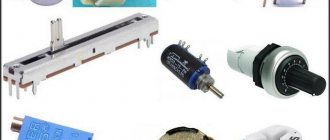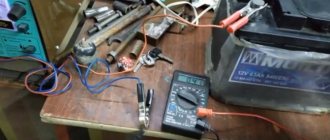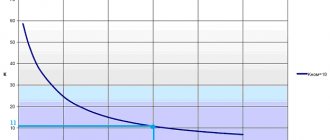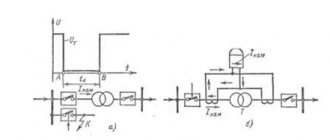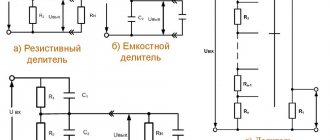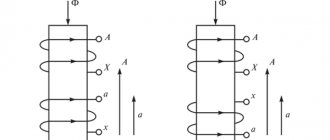Gas protection of transformer on-load tap-changer on jet relay
The gas protection of the on-load tap-changer of the transformer is made on a jet relay and acts to turn off the transformer when there is an intensive movement of oil flow from the on-load tap-changer tank towards the conservator.
The on-load tap-changer contactors are located in a compartment separate from the transformer tank. Since the arc burns in the oil when switching contactors, the oil gradually decomposes, releasing gas and other components. This oil does not mix with the rest of the oil in the tank and does not degrade its quality. The on-load tap-changer tank is also connected to the expander (separate compartment) and a special relay, for example, type URF-25, is installed in the connecting pipe.
Jet relay URF 25, URF 25/10
This relay is called a jet relay and only operates when oil is released. Once activated, the jet relay remains in the actuated position and must be returned to its original position by pressing the button on the relay. The relay is also equipped with a test button, by pressing which you can turn off the transformer.
The jet relay URF 25/10 is installed in the pipeline between the step switch head and the expander. Installing a relay allows you to control the oil flow. If the oil flow speed exceeds the response threshold of the valve gate (0.9-4.0 m/s ±15%, depending on the valve gate), the switching contact is switched on and the transformer is switched off.
Video: Monitoring the insulation of gas protection circuits
The video describes the features of organizing gas protection and the principles of operation of the Phlox insulation monitoring relay. In addition, the presentation will be useful to everyone who is beginning their acquaintance with the topic of transformer relay protection.
Safety requirements and environmental protection
General technical conditions for power transformers are given in []. GOST includes technical requirements, safety requirements, including fire safety requirements, environmental protection requirements, operating instructions, transportation and storage. Safety requirements must also comply. According to the standard [], grounding of transformer tanks is carried out.
The degree of protection of transformers is determined by the standard []. It states that all transformers, except built-in ones, must be made with protection class 1 or 2 and have a degree of protection of at least IP20. Stationary transformers, in turn, can be manufactured with a degree of protection IP00. The system of standards [] provides requirements for transformer disposal. It describes the following series of actions:
- transformer oil should be drained and sent for regeneration;
- metal components of the transformer must be recycled;
- porcelain insulators, electrical cardboard, rubber seals must be sent to a solid waste landfill.
Links and literature
. Rozhkova L.D., Kozulin V.S. Electrical equipment of stations and substations. - M.: Energoatomizdat, 1987. - 315 pp. Neklepaev B.N. Electrical part of power plants and substations. Textbook for universities. 2nd ed. - M.: Energoatomizdat, 1986.-310 pp. Rules for the technical operation of electrical installations. Approved by order of the Ministry of Fuel and Energy of Ukraine dated July 25, 2006. GOST R 52719–2007. Power transformers. General technical conditions. – M.: Standards Publishing House, 2007. – 45 pp. GOST 12.2.007.0–75. System of occupational safety standards. Electrical publication. General safety requirements. – M.: Standards Publishing House, 1975. – 12 p.. GOST 12.2.007.2–75. System of occupational safety standards. Power transformers and electrical reactors. Safety requirements. – M.: Standards Publishing House, 1975. – 5 p.
Voltage regulation at step-down substations
To regulate voltage by substation transformers, it is possible to change the transformation ratio within 10 - 20%. According to their design, there are two types of switching devices:
- with regulation without excitation (PBV), that is, to change the transformation ratio, the transformer is disconnected from the network;
- with load voltage regulation (OLTC).
The on-load tap-changer device is more expensive than the tap-changer device. The cost of the device depends little on the power of the transformer. Therefore, the relative increase in cost of a transformer with on-load tap-changer will be significantly greater for transformers of lower power. In this regard, transformers with voltages of 6 - 20 kV are mostly made with tap changers, and transformers with voltages above 35 kV with on-load tap-changers.
The on-load tap-changer is usually installed on the high voltage winding for the following reasons:
- on the higher voltage side there are lower currents, so the device has smaller dimensions;
- the higher voltage winding has a larger number of turns, so the control accuracy is higher;
- According to the design, the high voltage winding is external (magnetic core - low voltage winding - high voltage winding). Therefore, it is easier to inspect the on-load tap-changer;
- The on-load tap-changer is located in the neutral of the highest winding. The higher voltage windings are connected in a star, and the low voltage windings are connected in a delta. Three-phase regulation is easier to perform on star-connected windings.
For transformers with a voltage of 110 kV with a power of 2.5 MVA and a voltage of 150 kV with a power of 4 MVA, the on-load tap-changer is located on the low voltage winding.
Transformers have a different number of branches and different stages of regulation of the on-load tap-changer. Transformers with PPV always have 4 additional branches - .
On-load tap-changer devices and the automatic control systems that control them are characterized by:
- voltage value of the control stage;
- dead zone;
- response time delay;
- control accuracy.
The regulation stage is the voltage between adjacent branches. It is expressed as a percentage of the rated voltage of the winding that has control branches. The dead zone is a certain range of voltage changes at which the control equipment does not operate. The dead zone of the regulator should be slightly larger than the regulation stage: otherwise the regulator will operate unstably. The time delay of the regulator serves to prevent its operation during short-term voltage changes. The deadband and time delay of the controller determine the accuracy of the control.
Autotransformer on-load tap-changer
The on-load tap-changer of the autotransformer is located at the linear end of the medium voltage winding (Fig. 18.4). With this arrangement of the on-load tap-changer, the transformation ratio between the high and medium voltage windings changes. The transformation ratio between the high and low voltage windings does not change. At first, the on-load tap-changer of autotransformers was built into the neutral, like in transformers. During regulation, the transformation ratio between all windings changed. With this implementation, it was difficult to harmonize the voltage regulation requirements of consumers on the low and medium voltage sides. When the on-load tap-changer is located at the linear end of the medium voltage winding, the low voltage winding becomes unregulated. If there is a need to regulate the low voltage winding of the autotransformer, a linear regulator is connected in series with the low voltage winding. From an economic point of view, such a solution turns out to be more feasible than constructing an autotransformer with two on-load tap-changers.
Making branches on the neutral side makes it easier to insulate the on-load tap-changer and calculate it for the difference in the currents of the high and medium voltage windings ( I
B –
I
C).
But regulation will be tied. Making taps at the linear end of the medium voltage winding, the device must be designed for the full rated current, and its insulation for the voltage of the medium voltage winding U
C. But the regulation will be independent.
According to the figure, the operating current flows through closed contact 1 and auxiliary contact 2. Switching occurs in the following order. When moving from stage a
to a degree
of
first, operating contact 1 opens, then auxiliary contact 2. The load current flows through
resistance
R. Arc extinguishing contact 3' closes. A bridge is formed - the equalizing current flows through both active resistances R
and
R
'. Arc extinguishing contact 3 opens and transfers the load current to the right shoulder. Contacts 2' and 1' close. A new working position is created.
Lecture No. 19
Voltage regulation methods.
Voltage regulation devices (continued)
Plan.
1. Selection of branches of a two-winding transformer.
2. Selection of branches of a three-winding transformer and autotransformer.
Transformer on-load tap-changer
When performing adjustment work in transformers, on-load tap changers are used. They allow you to regulate the voltage on the windings without stopping the operation of the device. Thus, the transformer on-load tap-changer is the ability to regulate under load without turning off the power and without leaving consumers without power supply.
Operating principle of transformer on-load tap-changer
These devices cannot be compared with conventional relays. However, the operating principle of the on-load tap-changer is quite simple. Each phase terminal of the transformer has two moving contacts.
One of them is pressed against the winding turn corresponding to a given voltage value. During transfer, the second free contact is pressed to the next turn, where the voltage is different. After this, the first pressed contact is separated from the coil. Thus, the output is reconnected to another turn without breaking the circuit.
Load adjustment can be done manually or electrically. To ensure safe conditions for personnel, the manual drive is used when the transformer is switched off. The electric drive is controlled remotely, often in automatic mode. Adjustment under load is carried out on transformers with high power.
Sometimes, in addition to on-load tap-changer regulation, off-load tap changeover without excitation is used. This type of regulation is rarely used, as a rule, during seasonal adjustments of a switched-off transformer.
On-load tap-changer
If voltage regulation is carried out by switching the outgoing windings, then in this case, their transformation ratios are changed. At the same time, the number of high and low voltage windings in operation is taken into account. A certain section of the winding, where there are branches, performs the functions of a control winding. Thus, the transformer on-load tap-changer is a device that allows adjustments to be made over a wide range.
The adjustment range under load can be expanded through special circuits that involve the use of reversal. This allows you to avoid increasing the number of taps. The on-load tap-changer is most often switched on from the neutral side, which makes it possible to measure voltage with reduced insulation.
A standard on-load tap-changer includes a contactor for making and breaking the circuit, a selector for making and breaking the dead network, as well as a current-limiting reactor and drive mechanism.
https://youtube.com/watch?v=Z-ha_2vaQ3M
Types of power regulators
Different power regulators are used for different purposes.
Thyristor control device
The design of the device is quite simple. Typically, thyristors are used in low-power devices. A thyristor thermostat consists of bipolar transistors, the thyristor itself, a capacitor and several resistors.
Thyristor transistor regulator
Transistors form a pulse signal; when the capacitor voltage is equalized with the operating voltage, they open. The electrical signal is transmitted to the output of the thyristor, after which the capacitor is discharged and the key is locked. The entire sequence of actions is repeated cyclically.
Note! The amount of delay is inversely proportional to the power supplied to the load.
Triac power converter
A triac is a subtype of a thyristor, in which there are slightly more pn transitions, which is why its operating principle is somewhat different. But a triac is often considered a separate type of power stabilizer. The design consists of 2 thyristors connected in parallel and having common control.
For your information! This is where the name “triac” comes from - “symmetrical thyristors”. Sometimes it is also called TRIAC.
Diagram of 2 parallel connected thyristors (left) and triac (right)
The diagram shows that the triac has the designations T1 and T2 instead of the anode and cathode. This is because the concepts of “cathode” and “anode” in this case do not make sense, since electric current can exit through both terminals.
Triac universal regulators have a number of advantages, including low price, long service life and the absence of moving contacts, which can be sources of interference. But there are also disadvantages: susceptibility to interference and noise, lack of support for high switching frequencies.
Important! They are not used in high-power industrial installations; instead, thyristors or IGBT transistors are used.
You may be interested in Connecting transistors
Phase transformation method
Phase transformation occurs in so-called dimmers. Such devices are used, for example, to change the lighting intensity of halogen or incandescent lamps. The electrical circuit is usually implemented on special microcontrollers, which use their own integrated voltage reduction circuit. Due to their design, dimmers can smoothly reduce power.
LED dimmer
The disadvantages of such devices are high sensitivity to interference, high ripple factor and low signal power factor at the output. To stabilize the dimmer, dual thyristors are used.
On-load tap-changer and telemechanics: automation of voltage adjustment
Switching the transformer trunnion is an extremely important procedure, especially for substations of 110 kV and above. As noted earlier, the process involves the activation of an on-load tap-changer, the switching of which can be displayed on the dispatcher’s console. For this, telemechanics are used, which can send a signal via a fiber-optic cable to increase or decrease the voltage level.
The general scheme involves the following elements in the chain:
- The presence of a server room that sends and receives signals to the substation, as well as a computer in the control room. The transmission of information involves the use of a conductor, where optical fiber is most often used. Twisted pair cables are also common here, but the information transfer speed is significantly lower.
- At the substation, in the telemechanics cabinet, the cable is connected to a block that interacts with the on-load tap-changer. There are two kinds of raise/lower commands at the output. After the operation, a response is sent to the server, which manifests itself in the execution or non-execution of the task.
- To determine the voltage level, telemetry measurements are displayed on the computer. When adjusting, the latter should change up or down depending on the signal sent.
Automation and telemechanics provide significant comfort in maintaining routine instructions. Building a system largely depends on the technologies and technical means used. It should be noted that building an automated work system is the next step in comfortable regulation of the regime according to the schedule.
What is a power regulator
The very first prototypes of devices that make it possible to reduce the power transmitted to the load were developed taking into account Ohm's law. The functioning of the rheostat is based on this principle. It can be connected in series or parallel to the load. By changing the resistance of the rheostat, you can adjust its power.
What is a power regulator?
When a rheostat is connected to a load, the current is distributed between them. Depending on the connection method, you can control different parameters: with parallel, the potential difference, and with series, voltage and current. Rheostats vary depending on the material used in their construction: metal, ceramic, carbon or liquid.
When using a rheostat, the energy absorbed by it does not disappear anywhere, but is converted into heat. When there is a large amount of energy, it is advisable to use cooling systems so that the temperature of the device does not become too high. Heat is usually removed by blowing or by immersing the resistor in oil.
Such simple rheostats are widely used, but there is one significant drawback - the inability to use it in powerful electrical circuits. Therefore, resistors are used only for domestic purposes (for example, there are such in the design of radios).
Note! You can make a regular rheostat yourself; all you need is nichrome or constantan wire. It must be wound onto a mandrel, and the passing power changes by adjusting the length of the wire.
All semiconductor devices are made on junctions or layers (np, pn). A simple diode - 1 junction and 2 layers. Bipolar transistor - 2 junctions and 3 layers (three-phase). And when the fourth layer is added, a power stabilizer is formed - a thyristor. When 2 thyristors are connected back-to-back, a triac is obtained.
You might be interested in Industrial limit switches: description and application
Challenges and need for regulation
Any modern consumer of electrical energy (industrial enterprise, residential building) requires electricity in sufficient quantity and good quality. The quality of electrical energy refers to its frequency, symmetry and the magnitude of the three-phase voltage supplied to the consumer.
For economical and trouble-free operation of any consumer, it is necessary that the deviations in the actual value of the voltage supplied to it be minimal. In any case, these deviations should not exceed the norm established for a given receiver. Such standards are determined, for example, by GOST 13109-67 and the “Rules for the construction of electrical installations” (PUE) and should not be violated. Thus, for electric motors, the voltage at the terminals should not differ from the nominal voltage by more than within the range from -5 to +10%. When the voltage decreases, for example, by 10%, the motor rotation speed will decrease and the rotor and stator currents will increase, which will lead to overheating of the motor windings and a reduction in the service life of its insulation.
Lighting installations are very sensitive to voltage deviations, for which the permissible voltage deviation is ±5% for residential premises and from -2.5 to + 5% for public buildings and industrial premises. When the voltage decreases, the illumination sharply deteriorates, and when it increases, for example, by 10%, the service life of the lamps is reduced by approximately three times.
For some electric arc furnaces, a voltage drop of 8% forces the steel melting to stop, i.e. it is an emergency.
Thus, voltage fluctuations lead to significant damage and one should strive to keep them to a minimum. However, this is very difficult to do, since the causes of voltage fluctuations are inevitable changes (switching on and off) of the load and variable operating modes of electricity consumers. Voltage fluctuations are, in principle, inevitable, so constant regulation is required to maintain the voltage level constant.
How to make a power regulator with your own hands
To assemble a voltage stabilizer on a triac for a transformer, you will need the following components:
- the triac itself and electronic components: dinistor, potentiometer, diodes, capacitor and resistance;
- radiator;
- insulating heat transfer pad;
- plastic case;
- printed circuit board;
- multimeter;
- soldering iron
Homemade stabilizer Step-
by-step instructions on how to assemble a homemade power regulator:
- First, you need to determine some characteristics of the device for which you need a regulator: input voltage, current, how many phases (3 or 1), and whether there is a need to fine-tune the output power.
- You need to decide on the type of device - digital or analog. You can simulate an electrical circuit using downloadable utilities such as CircuitMaker or Workbench to check how well the type you choose will suit your particular electrical network. This can also be done online.
- Afterwards, you can begin calculating heat release using the formula: voltage drop in the regulator multiplied by the current. Both parameters must be specified in the triac specifications. Based on the power obtained using the formula, you need to select a radiator.
- Buy a heatsink, electronic components and a printed circuit board.
- Wire the contact paths and prepare the places where you need to install electronic components, a triac and a radiator.
- Using a soldering iron, secure all components to the printed circuit board. As an alternative to the board, you can use wall mounting with short wires. You need to carefully monitor the polarity of the connected components: triac and diodes.
- Take a multimeter and check the resistance of the resulting circuit. The resulting value should not differ from the theoretical one.
- Fasten the triac and radiator by placing a gasket between them and insulating the screw that connects them.
- The resulting microcircuit must be placed in a plastic case.
- Set the potentiometer to the minimum value and try to turn it on. Using a multimeter, measure the voltage at the output. Slowly turn the adjustable potentiometer knob, observing the voltage change.
- If the circuit works as intended, then the load can be connected. Otherwise, you need to adjust the power differently.
You may be interested in everything about the acoustic switch
2.1. Adjustment of the MZ-4 drive mechanism
2.1.1. Inspect the PM in accordance with paragraph .
2.1.2. Check the presence of protective grounding of the PM housing.
2.1.3. Check the insulation resistance of the control circuits, position indicator and motor in accordance with current standards.
2.1.4. Check the presence of lubricant in the PM gearbox and, if necessary, top up according to the PM instructions.
2.1.5. Run the PM in all positions using the handle. An increase in the torque on the handle is allowed only before operating the contactor when charging the springs of the high-speed mechanism and while the changeover selector is operating.
2.1.6. Check the functionality of the switching number counter and position indicator in the PM.
2.1.8. Check the decoupling of the gearbox mechanism and the output shaft when going beyond the extreme positions, after 4 - 6 revolutions of the output shaft. During reverse movement, automatic coupling of the gearbox and shaft should occur.
2.1.9. When running the PM, check the reliable closure of the contacts of the controller S11 (S12) during switching and the operation of the controller S13. At the end of the switching, rollers 3 should be in the middle position and all contacts S11, S12 should be open, as shown in Fig. .
If necessary, it is possible to adjust the controller washer S11, S12 by loosening bolts 5.
It should be borne in mind that upon completion of regulation it is necessary to remove an incomplete pie chart of the control unit (see paragraph).
As a result of regulation, when the PM is in the “normal position”, the following elements should coincide:
— the rollers of the controllers S11, S12, S13 should be in the middle position (all contacts S11, S12 are open);
— under the control window on the worm gearbox of the upper flange of the PU, the marks must coincide;
— the indications of the position indicators of the PM and PU must match.
2.1.10. Set the PM to position 6 and turn on the circuit breaker. After turning it on, the HL2 signal lamp should light up.
Check the functionality of the PM from the local control buttons. Turning off the circuit breaker by a remote release after the PM begins to move indicates incorrect phase rotation in the power circuits.
Rice. 2.1. Drive mechanism controller MZ-4:
1 — command washer of controller S11, S12; 2 — command washer of controller S13; 3 — controller roller; 4 - controller; 5 - bolts
In this case, it is necessary to swap the two power phases in the PM.
When testing a PM from an electrical circuit, it is necessary to pay attention to the precise operation of the contactors. If there are signs of sticking or rubbing, they should be completely inspected.
Pay special attention to the reliability of the one-time switching contactor K4, since its failure leads to non-stop switching to one of the extreme positions.
During switching, the HL1 signal lamp should light up in the PM.
2.1.12. Check automatic passage of intermediate positions (if any).
2.1.13. Check that the PM is adjusted to the normal position towards which the switching was started, if the power disappears during switching and then restore it. To do this, while driving the PM, turn off the automatic power switch and then turn it on again.
2.1.14. Check the effect of electrical interlocks in extreme positions when controlling the PM from buttons and interlocks against mismatches of three single-phase PUs during remote control.
2.1.15. Make sure that the PM passes through only one position during a long command to switch from the control buttons.
2.1.16. Check the possibility of control from the buttons located on the door of the PM cabinet when it is closed.
2.1.17. Check the serviceability of the power supply for the remote position indicator, the absence of breaks in the resistance unit and the functionality of the indicator over the entire range.
2.1.18. Provide power to the heating circuit regardless of the time of year, since the PM is equipped with a thermostat. The heating is switched on automatically when the temperature in the PM cabinet drops to approximately +10 °C.
2.1.19. Check the reliability of the PM at a supply voltage of 0.85 U
nom.
On-load tap-changer: operating principle
As noted above, the transformer trunnion can be adjusted through the on-load tap-changer. A special type of switching involves constant voltage adjustment depending on the time of day and load. Regulation is carried out in the range from +/- 10 to 16%. In some cases, a fully automatic mechanism is installed that supports the desired operating mode independently. Other options depend on operational control from the control center or control center.
As for the operating principle, it is done as follows:
- There is an antsapf, which by unscrewing the spring changes the number of windings. Under normal conditions, 33 turns implies a change in the number of turns by 1 unit. The measure of regulation is largely determined by the pitch adjustment.
- To automate the process, a mechanical motor is connected, which is tuned to perform exactly one operation. A signal is sent from the control unit to the electric motor, after which regulation occurs.
- For a faster response, it is necessary to use telemechanics, which provides the process from the control room.
Classification
There are several types of on-load tap-changers, differing in the following characteristics:
- a type of current-limiting element - with reactors or resistors;
- presence or absence of a contactor;
- number of phases – single-phase and three-phase;
- type of current switching.
Explanation of marking for on-load tap-changer type UBB...
Depending on the method of current switching, there are the following types of devices:
- the arc breaks in a volume filled with transformer oil - the device involves the use of arc extinguishing contacts that do not require the use of special elements to extinguish the arc;
- the arc breaks in a rarefied space - it is suggested to use vacuum arc extinguishing chambers produced industrially;
- shutdown is carried out using thyristors, in an arcless manner;
- combined methods - with a combination of different types of switching.
Also read: Electrical safety signs and posters used in electrical installations
To ensure the safety and functionality of the on-load tap-changers, they are equipped with automatic monitoring elements and voltage regulators.
In addition to the above devices, special booster transformers can be used to change the voltage characteristics in powerful units. This equipment is connected in series and used together with the main unit as an auxiliary unit. But this method has not been widely used due to the high cost and high complexity of the circuit.
Gas relay operating principle
Gas protection (GZ) is carried out using special gas relays. The gas relay is a metal casing embedded in the oil line between the transformer tank and the conservator. The relay is filled with oil.
gas relay transformer
The casing has a sight glass with a scale, which is used to determine the volume of gas accumulated in the relay. On the cover of the gas relay there is a tap for releasing air and taking a gas sample for analysis, and there are also contacts for connecting the cable.
The designs of gas relays differ in the principle of execution of the reacting elements in the form of:
- float;
- blades;
- cups.
Float relays gas relay
Float relays have two floats mounted on hinges inside the casing, which are hollow metal cylinders. The floats are equipped with mercury contacts connected by flexible wires to terminal clamps on the relay cover. The mercury contact is a glass bulb with two contacts soldered into its vertical part. The cones contain a small amount of mercury, which at a certain position of the cones closes contacts with each other, thereby creating a circuit through a relay. When the speed of gas and oil flows is about 0.5 m/s, the lower float located in the flow path overturns and its mercury contacts close in the shutdown circuit. Due to the fact that in the event of a short circuit (short circuit) violent gas formation immediately occurs in the transformer, the GZ produces a shutdown within a short time of 0.1-0.3 seconds. The disconnecting element also operates when the oil level in the relay housing is greatly reduced.
Rice. 9.4 Float gas relay, principle of operation
Paddle relay gas relay
The principle of operation of gas protection, a paddle-type relay is similar to the operation of a float-type relay, differs in that its main element consists of a float and a blade, they are connected to a mercury contact, which gives a shutdown command.
Rice. 9.5 Vane gas relay operating principle
Cup relays
Cup relays use open metal cups instead of floats and usually open contacts operating directly in oil instead of mercury contacts. It is normal for the relay body to be completely filled with oil, while the upper and lower cups are also filled with oil and are held in their original state by springs.
Cup gas relay
The most famous and widespread gas relay is the RGChZ-66 type, produced by the Zaporozhye Transformer Plant.
Currently, gas and jet transformer protection relays of the RGT50, RGT80, RST25 types, developed by ORGRES and VNIIR, are produced. These relays have advantages over older designs.
Features of phase shifting devices
A feature of the phase-shifting transformer is the possibility of its use only for industrial purposes, the scale of which justifies the cost of manufacturing such a unit. For personal consumer needs (in private households, for example), its use is unjustified and completely pointless.
The specifics of these devices also include:
- Significant dimensions, comparable to the dimensions of linear transformers of supply substations.
- Low efficiency, determined by losses in its own electrical circuits.
- High cost of manufacturing and installation of conversion equipment.
The cost of phase-shifting transformers is quite high due to the complexity of their circuitry. However, the money spent on them is more than repaid by the gains that can be obtained by optimizing the operation of the load circuits. This circumstance becomes especially relevant when operating lines in which sufficiently powerful consumer loads are installed.
Automatic voltage regulation
The number of turns switch is installed in order to provide a change in voltage in the lines connected to the transformer. It is not necessary that the goal always be to maintain a constant secondary voltage across the transformer. Most often, voltage drops occur in the external network - this is especially true for long-distance and powerful loads. To maintain the rated voltage at distant consumers, it may be necessary to increase the voltage on the secondary winding of the transformer. The on-load tap-changer control system relates to relay protection and station automation - the number of turns switch only receives commands: increase or decrease. However, usually the functions of matching transformation ratios between different transformers within the same station belong to the on-load tap-changer system. When connecting transformers in parallel, their turn number switches must move synchronously. To do this, one of the transformers is selected as the master, and the others as slaves, their on-load tap-changer control systems monitor the change in the transformer ratio of the master transformer. Usually, by synchronously switching the number of turns, one achieves the elimination of circulation currents between the windings of parallel transformers (due to the difference in the secondary voltages of parallel transformers), although in practice, at the moment of operation of the on-load tap changer, circulation currents still arise due to mismatch during switching, but this is allowed within certain limits.
Transformer voltage regulation
For normal operation of consumers, it is necessary to maintain a certain voltage level on the substation buses. Electrical networks provide methods for regulating voltage, one of which is changing the transformation ratio of transformers.
It is known that the transformation ratio is defined as the ratio of the primary voltage to the secondary, or
where wbw 2 is the number of turns of the primary and secondary windings, respectively.
The transformer windings are equipped with additional branches, with the help of which the transformation ratio can be changed. Switching of branches can occur without excitation (PBB), i.e. after disconnecting all windings from the network or under load (OLC).
The PBB device allows you to regulate the voltage within ±5%, for which low-power transformers, in addition to the main output, have two branches from the high-voltage winding: +5% and -5% (Fig. 2.39, o). If the transformer was working on the main terminal 0 and it is necessary to increase the voltage on the secondary side U 2, then by turning off the transformer, switch to the -5% branch, thereby reducing the number of turns W\.
